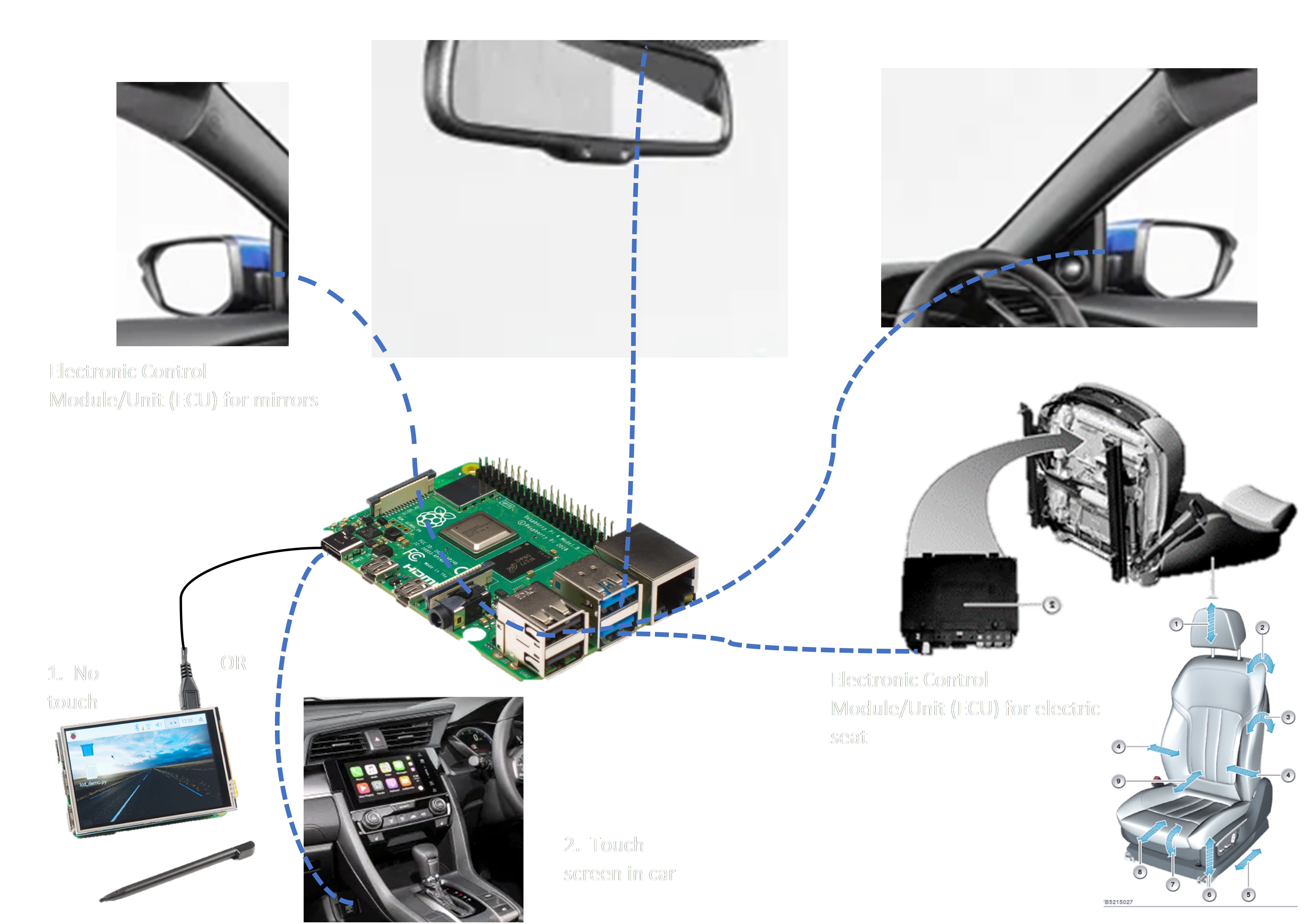

This project is taking the focus of the use of motor vehicles: cars, and the user-centred design of the drivers of such a car with their seating and mirrors positioning; key functional and observatory features of a common vehicle. Using innovative hardware such as a Raspberry Pi and the development of a software; it is believed that the driver’s seat and mirrors and their positioning (their settings) can be managed, stored and automatically adjusted (on starting of the car) to better be suited when there are multiple dedicated drivers of one common 21st-century car.
When you have another person drive your vehicle or a vehicle you regularly use, they move the seat and mirrors and it can be annoying and a time wasting process to change them back every time and getting it perfect again when you go to drive the vehicle. What if you could manage, store, and automatically adjust each drivers’ personal settings; the seat and mirrors to accustom the dedicated driver (at the time) on start up every time. Some newer cars have memory buttons that save the driver’s seat and mirror (side and rear view) positions, but what if this could be implemented or integrated into almost any car of the 21st century using Raspberry Pi (small single board computer) technology with a developed software that stores, manages and actions adjustments?

This product and software; the system as a whole, could potentially reach more of an audience if it was external to a car’s multiple computer/Electronic
Control Unit (ECU) (for the drivers electronic seat and mirror: side and rear view) and running on a Raspberry Pi and dedicated software; as it could potentially
function on more 21st century cars.
The innovation of the Raspberry Pi:
A series of pocket sized single-board computers known as The Raspberry Pi have taken over the world of automation and robotics. The innovative series of “Pi sized”
computers was originally aimed “at promoting the teaching of basic computer science in schools and in developing countries”, now it aids in solving an infinite number of problems.
The Raspberry Pi has the ability to replace our common desktop computers and some versions can be used as a USB (Universal Serial Bus) device or USB host; “plugged into another
computer via a USB port on another machine”. With multiple configuration methods it can show up as a serial device or an ethernet device, with the ability to USB and network boot.
Also noting that the latest Raspberry Pi 4 has complete POE (Power-over-Ethernet) support, through full gigabit ethernet, on-board Wi-Fi and Bluetooth capability. (Wikipedia, 2020)
Once everything is plugged in and hard-wired (the Raspberry PI is plugged into power or USB and a display: to show UI) and the car (that is used by
multiple people) is turned on for the first time with the external device (the Raspberry Pi) that will (have software that will) manage, store and run
adjustments on the car’s driver’s seat, side and rearview mirrors for each dedicated driver, there is an initial setup wizard that is a part of the software.
The initial setup wizard or initial setup U.I. that will show on the display will be as follows:
“Welcome to [TBC Software Name], what is your name?”
“_________________” [Click box and use on screen keyboard/external keyboard to type name]
“Next”
[Next page]
“Please adjust your seat (position and back angle) and mirrors (side and rear view) to your liking and then click Save.”
[Will need to manually adjust electronic seat and back angle and mirrors (side and rear view) to your liking with buttons/switches that
manufacture has provisioned]
“Save”
[Next page]
“Your profile name and settings have been saved, on next startup, these will be automatically adjusted (if not already) to accustom you, thank you.”
The software (that is to run on the Raspberry PI) is to:
| “Driver Profile 1” | “Driver Profile 2” | “Driver Profile 3” | “Setup New User” |
(refer to above Initial setup)
Once a driver’s profile is selected, the automatic adjustments for the driver’s seat, side mirrors and
rear mirrors will be run.
Primary owners of one vehicle that will have multiple people driving their car/or the car they use regularly.
“When you have another person drive your car, they move the seat and mirrors, and it can be annoying to change them back every time
when you go to drive your car. What if you could manage, store, and automatically adjust each drivers’ personal settings of one car; the
seat and mirrors to accustom the dedicated driver (at the time) on start up every time. Some newer cars have memory buttons that save the driving
seat and mirror (side and rear view) positions, but what if this could be implemented or integrated into almost any car of the 21st century using
Raspberry Pi technology with a developed software that stores, manages and actions adjustments?”
If the project is successful, there will a functional system: an external system (external to the vehicle’s ECU’s (Electronic Control Unit)):
hardware and software that stores, manages and automatically actions adjustments of the driver’s seat and the side and rear view mirrors in a vehicle
that will have multiple drivers.
What does this mean for the intended audience?
A convenient, time saving and effective solution to the annoying, time wasting hassle of having to change the seat and mirrors back every time and making
sure they are perfect after someone else drives the car.
The project also extends to future possibilities, where system can be implemented and installed on commercial vehicles: fleet cars, work cars, etc. The project also has the possibility to be integrated into a vehicles key fob, for convenient handheld use.
Raspberry Pi Foundation, 2020. Usage. [Online]
Available at:https://www.raspberrypi.org/documentation/usage/
[Accessed October 2020].
Wikipedia, 2020. Raspberry Pi. [Online]
Available at: https://en.wikipedia.org/wiki/Raspberry_Pi
[Accessed October 2020].